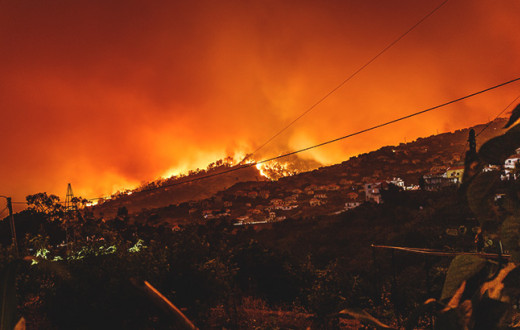By Elizabeth Herman | Posted: July 01, 2019
Can we solve the problem of climate change by getting anxious and depressed? How can we work constructively in the present moment when so many reports show that the earth is quickly becoming uninhabitable due to changes in our environment?
Lots of evidence shows that young people have higher levels of anxiety and depression because of their worries about the issue of climate change. Hurricanes, wildfires, floods, and other natural disasters are occurring with greater frequency and severity. But higher levels of depression and anxiety about the future won’t solve the problem. They only get in the way of bringing sustainability to the forefront of our minds.
Positive action for sustainability in the present moment
It’s true that active acceptance of the problem is necessary. Carbon emissions have increased in the past few years, despite warnings from scientists about all of the bad effects happening now. It’s true that they’ll get worse, unless society makes significant changes. Although many recommendations for positive action exist, the US has reversed many previous efforts to limit carbon emissions recently.
So the sadness about these issues may be necessary to motivate change. However, rather than give in to depression and anxiety, it’s time to get busy and more effectively support alternatives to fossil fuels. It’s time to make a difference by learning to do what’s necessary for a healthier relationship to nature. While working personally may be the first step, working collectively will grow from individual commitments.
Take time to look at your own life, and improve your own relationship to the planet. You’ll be much happier about our prospects for changing our energy use. The future is in your hands!
Tips for feeling good about the future of planet earth
1. Spend time with your attention on nature. Go outside and look at plants and animals, noticing leaf patterns, textures and shades of color. Listen intently to sounds of birds, squirrels, humans, wind, and flowing water.
Gurudev Sri Sri Ravi Shankar once said, “How can you care about the environment when you don’t feel for it inside? You must feel that this is a part of me. Like I care for my body, I have a care for the environment. This attention towards the environment becomes spontaneous when we release the stress from our daily activities.”
Join this webinar and learn how to transform your stress into ease using simple, powerful tools
2. Plant a garden and grow some of your own food. Seeds at any dollar store are very inexpensive and with a little bit of soil, compost, water and patience, they sprout baby plants. If you don’t have access to the actual earth itself, you can use pots, cardboard containers, plastic bags or any other creative method to grow food. Create a beautiful vertical garden if you can’t expand the garden horizontally. Upcycle plastic colanders, salad spinners, or wellies into flower pots.
3. Feed wild birds. These tiny creatures can brighten our moods with songs every morning, noon and night. Having evolved from dinosaurs, they’ve seen nature destroyed only to renew itself again. In North America, the black oil sunflower seed is very popular, but any seed combination will do. Bird feeders run from five dollars on up, or you can make your own by upcycling plastic milk bottles or other unused materials. Attract birds to your windows by hanging feeders on tree branches or any other available hook.
4. Upcycle (and recycle) plastics. Make your recyclables into things you can use. Do this to save energy on the part of the recycling system, and also to empower your own creative juices. The more you can fashion sustainable products yourself, the less you depend on polluting factories. Remember, your own two hands, when active, won’t emit carbon any more than they would if they were sitting idle.
5. Only use reusable grocery bags, water bottles (preferably non-plastic ones), drinking glasses, dishes, and utensils. This tip speaks for itself. But you must speak up at the grocery store and other food establishments, saying “No, thanks. I have my own bags,” and “Please put my sandwich in my own container for me,” etc. Have your lunch bag, plates, and bamboo silverware with you wherever you go, just in case you go to an event that uses those horrible styrofoam plates. Politely ask your hosts to fill a plate for you that you can reuse.
6. Choose food products without packaging (or with the least possible amount). Don’t put your fresh produce into plastic any more. Put all fresh produce directly into your reusable grocery bags, or into reused cardboard boxes. Fresh fruit without packaging is not only better for the earth, it’s better for you! If you can eat without throwing anything in the landfill, you will get better energy (and mental nourishment) from your food!
7. Throw away less trash and recycle more. Use your local area’s recycling program. Know what the bin can take and what it can’t. Educate yourself and others on how to recycle, and where the public receptacles for recycling are located. Express your positive support for the public employees who work to make sure we recycle at the community-wide level. They will appreciate you more and cheer you up!
8. Use non-toxic detergents for dishes and laundry, soaps and shampoos. As chemicals continue to leach into our water, we increase the dangers in floods and hurricanes. The water system on earth is continuous and can purify itself if it isn’t overwhelmed by harsh chemicals. Clean water, although becoming scarcer, can be managed and conserved with awareness and effort. Educate others on how to help natural and man-made systems purify water. Teaching is the best, most gratifying way to learn.
9. Choose a vegan or vegetarian diet. One of the worst causes of climate change happens to be meat production. Farming methods that don’t involve animals emit less carbon into the atmosphere and require less farmland. Countless meat substitutes exist, and the plant based abundance available on vegetarian menus and in stores is filling and satisfying. Thousands of wonderful, online vegan recipes are easy to prepare in your own home kitchen. Feel lighter and less depressed with veganism or vegetarianism.
10. Talk to people who share your caring attitude about the earth. Reach out to others who agree with you and may be going through the same thing. Organizations to help with climate grief are popping up all over. In the same way that 12-step programs have helped with alcoholism, codependency, abuse recovery, and other mental health issues, there’s now a 10-step program for climate grief sufferers. Find a friend and get busy, instead of sinking into depression or worrying.
11. Volunteer to help victims of natural disasters. In addition to hurricanes along the coasts and wildfires in drier areas, midwest regional flooding has been happening more and more frequently, as is flash flooding in the mountains. People displaced by floods need shelter and all kinds of supplies from those living on higher ground. You can donate to flood shelters, move sandbags into place around levees, or do any number of volunteer jobs when floods affect your area. Just make sure you venture outdoors safely, and protect yourself and others during a flood situation or other natural disaster.
12. Make sure all organic waste is composted or fed to farm animals, and kept out of landfill trash. Methane gas comes from agricultural waste as well as organic matter in our landfills. This gas contributes to climate change on a huge scale. Teach your friends and neighbors that landfills are no place for organic trash, including food scraps, cardboard, paper, etc.
Mission green earth
Social media can help a great deal. Share your feelings about climate change and ideas on how to stop it on social media. Inspire 5 more friends to join you in working for climate healing with #ClimateChange and #BeatPlasticPollution and #MyMissionGreenEarth, and tag us at fb.me/mymissiongreenearth or instagram.com/mymissiongreenearth to make a difference!
The Art of Living’s Mission Green Earth initiative in collaboration with the UN offers a way to get involved. Join us and help to rescue our only liveable planet from climate change. Whether some US political leaders believe it or not, it feels good to help a worthy cause like this one and have a healthy relationship with mother nature.
This content is not intended to be a substitute for professional medical advice, diagnosis or treatment. Always seek the advice of your physician or other qualified health providers with any questions you may have regarding a medical condition.
By Elizabeth Herman - PhD in English, with concentrations in Rhetoric and Composition, and Literature, she offers writing support to clients, teaches locally, lives in Boone, NC, and volunteers for a better world.



















